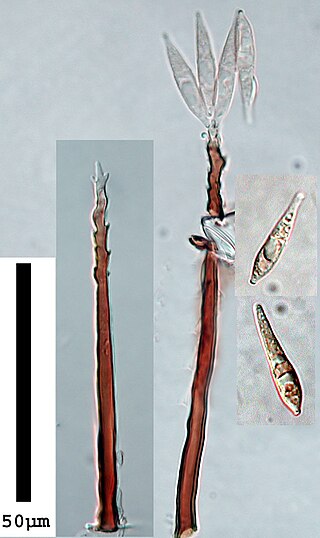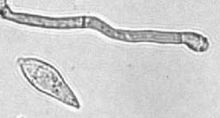
Magnaporthe grisea, also known as rice blast fungus, rice rotten neck, rice seedling blight, blast of rice, oval leaf spot of graminea, pitting disease, ryegrass blast, Johnson spot, neck blast, wheat blast and Imochi (稲熱), is a plant-pathogenic fungus and model organism that causes a serious disease affecting rice. It is now known that M. grisea consists of a cryptic species complex containing at least two biological species that have clear genetic differences and do not interbreed. Complex members isolated from Digitaria have been more narrowly defined as M. grisea. The remaining members of the complex isolated from rice and a variety of other hosts have been renamed Magnaporthe oryzae, within the same M. grisea complex. Confusion on which of these two names to use for the rice blast pathogen remains, as both are now used by different authors.

Botryosphaeria dothidea is a plant pathogen that causes the formation of cankers on a wide variety of tree and shrub species. It has been reported on several hundred plant hosts and on all continents except Antarctica. B. dothidea was redefined in 2004, and some reports of its host range from prior to that time likely include species that have since been placed in another genus. Even so, B. dothidea has since been identified on a number of woody plants—including grape, mango, olive, eucalyptus, maple, and oak, among others—and is still expected to have a broad geographical distribution. While it is best known as a pathogen, the species has also been identified as an endophyte, existing in association with plant tissues on which disease symptoms were not observed. It can colonize some fruits, in addition to woody tissues.
Brasiliomyces malachrae is a species of fungus in the family Erysiphaceae. It is a plant pathogen that grows on Gossypium, Lavatera assurgentiflora, Malachra capitata, Malvastrum coromandelianum, and species of Malvaceae. It is found in South America.

Beauveria is a genus of asexually-reproducing fungi allied with the ascomycete family Cordycipitaceae. Its several species are typically insect pathogens. The sexual states (teleomorphs) of Beauveria species, where known, are species of Cordyceps.

Mycosphaerella is a genus of ascomycota. With more than 10,000 species, it is the largest genus of plant pathogen fungi.
Harpophora is a genus of fungi in the family Magnaporthaceae.

Pyricularia is a genus of fungi which was named by Saccardo in 1880.
Stenella canavaliae or Stenella canavaliae-roseae, formerly known as Cercospora canavaliae is a species of anamorphic fungi. It causes the brown leaf mould of Canavalia species.
Stenella sinuosogeniculata is a species of anamorphic fungi.
Magnaporthiopsis is a genus of ascomycete fungi. It has three species.
Piricaudiopsis rhaphidophorae is a fungus occurring on dead branches of Rhaphidophora decursiva, hence its name. It was first found in a tropical forest in southern China. It differs from other Piricaudiopsis species in conidial morphology and in the proliferation of its conidiogenous cell. The presence or proliferation of the conidiogenous cells and the conidial appendages, as well as the height of its conidia are considered putative phylogenetic characters of this genus.
Piricaudiopsis punicae is a fungus occurring on dead branches of Punica granatum, hence its name. It was first found in a tropical forest in southern China. It differs from other Piricaudiopsis species in conidial morphology and in the proliferation of its conidiogenous cell. The presence or proliferation of the conidiogenous cells and the conidial appendages, as well as the height of its conidia are considered putative phylogenetic characters of this genus.
Chaetomium undulatulum is a fungus species in the Chaetomium genus, first isolated from Iran. It shares features such as peridium structure, ascospore morphology and germ pore position with its cogenerates. It is closely related to C. globosum.

The Pyriculariaceae are a family of ascomycete fungi in the order Magnaporthales. It was introduced by S. Klaubauf, M.H. Lebrun & P.W. Crous in 2014.

Tritirachium oryzae is a fungus in the Basidiomycota often mistaken for a member of the Ascomycota. it is a mesophile linked recently with human pathogenicity in multiple, rare cases. This species produces airborne spores and is an endophyte of several plant species in North America, South America and in the Middle East.

Colletotrichum fioriniae is a fungal plant pathogen and endophyte of fruits and foliage of many broadleaved plants worldwide. It causes diseases on agriculturally important crops, including anthracnose of strawberry, ripe rot of grapes, bitter rot of apple, anthracnose of peach, and anthracnose of blueberry. Its ecological role in the natural environment is less well understood, other than it is a common leaf endophyte of many temperate trees and shrubs and in some cases may function as an entomopathogen.
Magnaporthe rhizophila is a fungus species in the family Magnaporthaceae. These dark mycelial fungi are common pathogens of cereal and grass roots. Rice blast is one disease known to be caused by M. rhizophila and presents with vascular discoloration in the host organism. The fungus lives best in drier humid conditions, explaining why it is most often found in the soils of Australia, South Africa, and the Southeastern United States.
Fuscosporellales is an order of fungi within the phylum of Ascomycota and in the class Sordariomycetes and subdivision of Pezizomycotina.
Pleurotheciaceae is a family of ascomycetous fungi within the monotypic order of Pleurotheciales in the subclass Savoryellomycetidae and within the class Sordariomycetes.
Pleurothecium is a genus of terrestrial and freshwater fungi in the family Pleurotheciaceae and the monotypic order Pleurotheciales. It is typified by Pleurothecium recurvatum as the type species (Morgan) Höhn, which has the synonym of Carpoligna pleurotheciiF.A. Fernández & Huhndorf, Mycologia 9: 253. 1999.








